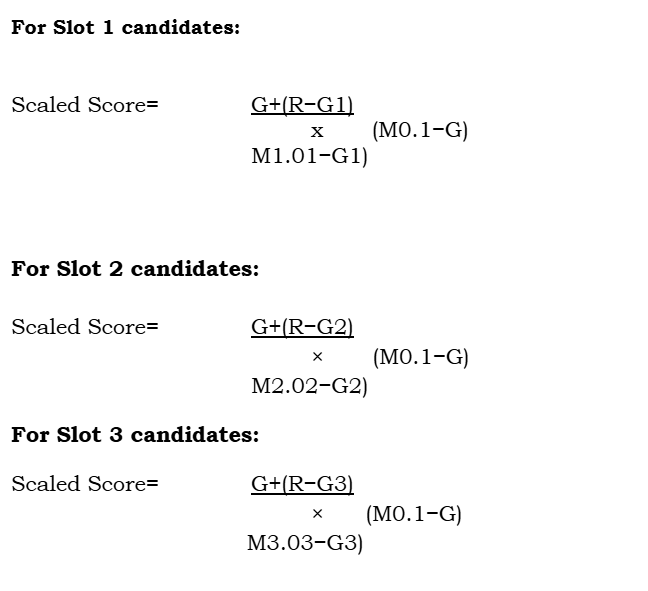Common Admission Test, or CAT, is a highly competitive MBA entrance exam that IIMs conduct annually. Since CAT is conducted in various test slots, there are varying questions for each student, leading to variations in the level of difficulty by slots.
To prevent any candidate from being unduly advantaged or disadvantaged, IIMs follow a statistical normalization technique called “Calculation of CAT Scaled Score” where raw scores are translated into scaled scores. The scaled score is very important in deciding the final CAT percentile, which ultimately determines a candidate’s admission probability in elite B-schools.
In this article, we shall understand the process of Calculation of CAT Scaled Score we will also understand why normalizing is needed, and what is the contrast between raw and scaled scores to facilitate greater comprehension for the aspirants in what they deliver

Get the first AiExpertEdge CAT Online Course with 20% Discount
Why Does CAT Use Score Normalization?
The Challenge of Multiple Slots
The CAT exam is conducted in several slots, typically three sessions on the same date. Since each slot has a different question paper, there are likely to be small variations in difficulty levels.
For example:
- Slot 1 Might have more challenging Quantitative Ability (QA) questions.
- Slot 2 Could have a more challenging Verbal Ability & Reading Comprehension (VARC) section.
- Slot 3 Could have a less challenging Data Interpretation & Logical Reasoning (DILR) set.
Unless the scores were normalized in these above cases, candidates sitting in a more difficult slot would be disadvantaged by candidates sitting in an easier slot when they are equally capable hence the CAT normalization comes into play.
Making it Fair with Normalization
To eliminate this imbalance, IIMs follow a statistical process called score normalization simply Calculation of CAT Scaled Score. This standardizes raw scores so that all candidates from a given slot are ranked on an equal footing. The scaled scores are then used to calculate percentiles so that there is a fair and unbiased ranking system in the CAT.
Raw Score vs. Scaled Score in CAT: Understand the Difference?
| Feature | Raw Score in CAT | Scaled Score in CAT |
| Definition | The actual sum of marks earned is calculated based on correct and wrong answers. | The normalized score after adjustment, taking slot-wise differences into account |
| Accounts for Slot Difficulty? | No, raw scores do not take into account varying levels of difficulty between slots. | Yes, scaled scores account for difficulty differences between slots. |
| Used for Percentile Calculation? | No, raw scores are not used directly for percentile calculation | Yes, they are utilized to assess the final CAT percentile computation |
| Shown on the Secard? | No, candidates never get to view their raw scores on the scorecard. | Yes, only scaled scores are shown on the CAT scorecard. |
Being aware of this difference matters because your scaled score determines your percentile, not your raw score, hence Calculation of CAT Scaled Score plays a crucial role<.
Step-by-Step Breakdown of Calculation of CAT Scaled Score
Step 1: Calculation of CAT Scaled Score
Your raw score is then computed based on the official CAT marking scheme:
- +3 marks for each correct response
- -1 mark for each incorrect response (in MCQs)
- No negative marking for non-MCQ (TITA) questions
For instance, let’s say a candidate has attempted 70 questions out of which 55 are correct and 15 are incorrect, then his/her raw score will be:
(55×3)−(15×1)=165−15=150
The raw score so obtained is again utilized in the normalization process.
Step 2: Calculation of Slot-Wise Mean and Standard Deviation
Every slot contains a unique set of candidates and difficulty levels. IIMs, hence, first calculate:
Mean Score (M1, M2, M3) – Overall mean score of each group of applicants in every slot.
Standard Deviation (S1, S2, S3) – Score variation in each slot.
They are employed to figure out how difficult or simple a slot is to others.
The formula applied:
- G1=M1+S1,
- G2=M2+S2,
- G3=M3+S3
where:
- G1, G2, G3 = Normalized thresholds per slot.
Step 3: Creating a Common Reference Point Across Slots
To provide a common baseline, IIMs calculate the mean and standard deviation across all slots taken together
M=Mean of all slots, S=Standard Deviation of all slots M = {Mean of all slots}& S = {Standard Deviation of all slots}
A reference threshold G is then computed as:
G=M+S
Step 4: Score Adjustment Based on Top 0.1% Performers
To further improve the process of normalization, IIMs calculate the top 0.1% of scores of each slot:
- M1.01 = Top 0.1% mean of Slot 1
- M2.02 = Top 0.1% mean of Slot 2
- M3.03 = Top 0.1% meanof Slot 3
A joint benchmark for top performers across all slots is derived as:
M0.1 = {Top 0.1% mean of all candidates}
This guarantees that the best performers are assessed equally in all slots.
Step 5: Scaling Formula Application to Get Final Scores
The last scaled score is calculated based on a statistical transformation formula:

where R is the candidate’s raw score.
Step 6: Computing Final Overall Scaled Score
Normalization is applied section-wise for every section of CAT (VARC, DILR, QA). The overall Calculation of CAT Scaled Score is then obtained by adding the section-wise scaled scores:
Final Scaled Score=Scaled Score in VARC+Scaled Score in DILR+Scaled Score in QA.
The final score is again used to compute percentiles and eligibility for admissions.
Why CAT Normalization is Important
Calculation of CAT Scaled Score is necessary due to the numerous reasons enumerated below:
- Guarantees Honest Assessment – It helps in eliminating the slot-wise difficulty disparities.
- Establishes a Level Playing Field – Objectively compares session scores.
- Guarantees Transparency – Imploys an evident statistical process in making adjustments in scores.
- Makes Your Final Percentile Determinant – Greater raw scores lead to better percentiles after scaling.
Conclusion
The CAT 2025 is held in more than one slot, hence Calculation of CAT Scaled Score and normalization is very necessary for fairness. As a test-taker, your goal should be to achieve the maximum raw score, since higher raw scores correspond to higher scaled scores and percentiles.
To improve your chances incorporate these habits:
- Practice speed and accuracy in all three sections actively.
- Practice more mock tests in timed mode.
- Analyse the past CAT trends to ascertain the difficulty levels of the exam.
With good preparation and wise test-taking techniques, you can score high on the CAT percentile and have a chance to get admission to a premier B-school!





